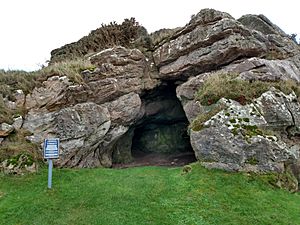Causantín mac Cináeda facts for kids
Quick facts for kids Causantín |
|
|---|---|
| King of the Picts | |
| Reign | 862–877 |
| Predecessor | Donald I |
| Successor | Áed |
| Born | c. 836 |
| Died | 877 (aged c. 41) possibly Inverdovat, Fife, Scotland |
| Burial | Iona |
| Issue | Donald II, King of the Picts/of Alba |
| House | Alpin |
| Father | Kenneth I, King of the Picts (Cináed mac Ailpín) |
Causantín mac Cináeda (died 877) was a powerful Pictish king. He ruled from 862 to 877. You might know him as Constantine I. This is because he is often listed as one of the early kings of Scots.
Causantín was the son of Kenneth MacAlpin, a famous king. He became king after his uncle, Donald I, passed away. During Causantín's time, Vikings were very active. They came from places like Ireland and Northumbria. King Causantín died fighting against one of these Viking invasions.
Contents
Understanding Old Languages in Britain
Long ago, many different languages were spoken in Britain. A writer named Bede listed five main ones. These were Latin, used by the church, and Old English, spoken by the Angles and Saxons.
There was also Irish, spoken in Ireland and parts of Britain. Brythonic was another, which later became the Welsh language. Finally, there was Pictish, spoken in northern Britain. By the 800s, a sixth language arrived: Old Norse, brought by the Vikings.
Viking Leaders: Amlaíb and Ímar
During King Causantín's rule, Viking attacks became very common. These Viking armies often had strong leaders. Two important ones were Ívarr (also called Ímar) and Amlaíb (also called Óláfr). They led their forces across Britain and Ireland.
In 865, a huge Viking army, known as the Great Heathen Army, landed in East Anglia. The next year, they moved north and took over York. This was a major city for the Northumbrians. Two rival kings, Osberht and Ælla, tried to fight them. But both were killed in the battle.
The Vikings then put their own king, Ecgberht, in charge of Northumbria. They also attacked Mercia, but King Burgred and his brother-in-law, King Æthelred, managed to push them back.
Viking Attacks in the North
While the south was under attack, other Viking groups were busy in the north. Amlaíb and his brother, Auisle, brought an army to Fortriu in 866. They took tribute and hostages from the people there.
Later, in 870, Amlaíb and Ívarr attacked Dumbarton Rock. This was a very important fortress for the kingdom of Alt Clut. The Vikings besieged it for four months. When it fell, they took many prisoners back to Ireland. These prisoners included Angles, Britons, and Picts.
After this, the king of Alt Clut, Artgal of Alt Clut, was killed. Some sources say King Causantín was involved in his death. Artgal's son, Run, later married Causantín's sister.
Amlaíb is not mentioned in Irish records after 871. The Chronicle of the Kings of Alba says King Causantín killed him. This happened when Amlaíb returned to Pictland to demand more tribute. Ívarr, Amlaíb's ally, died in 873.
The End of the Pictish Kingdom
In 875, Viking armies attacked Pictland again. Old records say there was a "great slaughter of the Picts." The exact battle name is not known.
In 877, King Causantín built a new church for the Culdees at St Andrews. Soon after, he was captured and killed while fighting Viking raiders. It is not clear exactly where he died. Some stories say he was beheaded on a beach in Fife. Others say he died in a place called the "Black Cave" or "Black Den."
King Causantín was buried on the island of Iona.
What Happened Next
King Causantín's son, Domnall, later became king. His family line continued to rule as kings of Alba, which later became Scotland.
See also
 In Spanish: Constantino I de Escocia para niños
In Spanish: Constantino I de Escocia para niños



